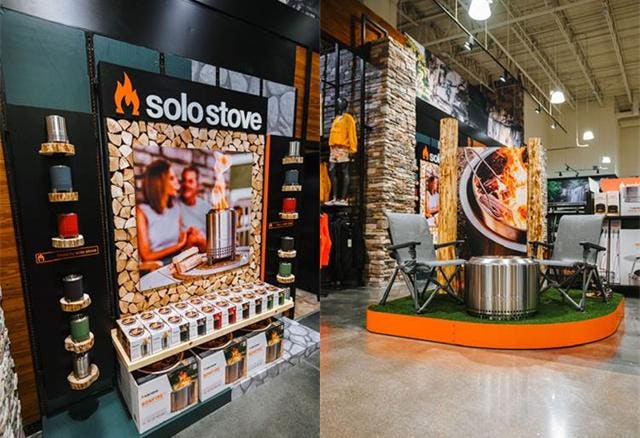Like many of Solo Brands’ digitally-native IPO cohort of 2021, it knew it needed brick-and-mortar retail to drive continued growth. But unlike others, such as Warby Parker, Brilliant Earth, Casper and Allbirds, it decided opening company-owned retail stores wasn’t the answer.
Having already established a wholesale customer base for its flagship Solo Stoves brand with Dick’s Sporting Goods, Ace Hardware, Costco, Home Depot and Lowe’s, to name a few, it chose to lean into those relationships as the cost of customer acquisition online grew and its product line expanded.
That decision is being rewarded as headwinds grow in the economy and consumers pull back from their pandemic-induced spending on home goods. Solo Brands is riding tailwinds provided by its omnichannel strategy, yielding short-term benefits and promising long-term ones as well.
In the first half of the year, wholesale revenues grew 55%, offsetting a 12% decrease in direct-to-consumer revenues. Overall, the company’s six-month revenues were flat, up only 0.4% to $219 million against $218.2 million last year.
Looking out over the second half of 2023, Solo Brands expects wholesale to get another shot in the arm when its Mesa tabletop firepit takes centerstage in some 2,000 Target
TGT
And its recent acquisition of TerraFlame, specializing in indoor fire products such as its S’mores tabletop roaster, brings existing relationships with Target as well as Pottery Barn, William Sonoma and Crate & Barrel, which could open doors for its outdoor firepits as well as other cooking products.
“We’ve been trying to grow our business in a more balanced omnichannel fashion,” CEO John Merris shared with me. “And our retail partners are not just responding with sell-in, but they’re replenishing. What surprised us most was how quickly the retailers, especially Costco, Dicks and Ace in particular, have responded for the fall.”
Reaping The Benefits
The company’s DTC and wholesale mix has shifted from about 80% DTC and 20% wholesale at the end of last year to 70%/30% now and the company is reaping rewards from the shift.
Profitable Wholesale
Conventional wisdom holds that DTC brands take a hit to profits if they go wholesale where keystone pricing is in effect, but Solo Brands reported being more profitable in wholesale than in its direct-to-consumer business. Some of that may be how it allocates digital advertising spend against its DTC business when it positively impacts both DTC and wholesale.
“In reality, these two channels are equally profitable, but we’re not putting any burden on the wholesale side of the business,” he said. Reflecting its positive profitability outlook, it raised its EBITDA margin target from 16.5% to 17.5% to 17% to 18% for the full year, after reaching an adjusted EBITDA margin of 19.1% in the second quarter.
While Solo Stoves is responsible for the bulk of the company’s revenues, its other brands, such as Oru Kayak, Chubbies sports apparel, Isle Paddle Boards and TerraFlame have a similar mix of wholesale and DTC businesses, including five Chubbies retail stores and one Isle surf pro-shop.
Balancing Seasonality For Greater Visibility
Another key benefit from leaning into wholesale is the company can shore up its slower first and third-quarter DTC business with wholesale when retailers write their orders to be stocked for the peak second and fourth quarters.
“We’re a cool weather business with our online business peaking in second and especially the fourth quarter, since our products are highly giftable,” Merris explained. “Direct-to-consumer is a real-time business so we need product on hand. Retailers need to order well in advance, so it brings balance to our business, allowing us to predict and forecast the business much further in advance than we’ve historically been able to.”
This will benefit the company’s top and bottom lines, enabling better inventory planning, forecasting and guidance visibility.
In addition, retailers are more focused on carrying the company’s marquee, foundational products, like its firepits. But because of space limitations, they may not carry as many accessories or some of the brand’s new products, like its pizza oven and patio heaters.
“Our emphasis has been getting firepits into our retailers and then driving customers back to our website for accessories and other product purchases,” he added. This effort will be further enhanced with point-of-purchase displays now being deployed in key retailers and new marketing inserts included in its product packaging that highlight its other brands with an incentive to try another brand.
Despite some cannibalization of its higher-ticket firepit sales online through its retail expansion, Merris reports actual order counts and the number of new customers grew during the second quarter due to its greater retail exposure.
Room To Grow
Thanks to its newfound understanding of how wholesale complements its DTC business and vice versa, it is taking that learning to international markets that remain a small part of the company’s business. Currently, it is building relationships with international retail partners, including Costo Europe.
The global firepit market is on fire, pardon the pun. Market size reached $6.8 billion in 2022 and is projected to grow at a compound annual growth rate of 6.5% through the end of the decade, according to Grand View Research.
Halo Effect
“We believe our omnichannel strategy will produce a halo effect as our brand recognition grows and customers look to our direct channel,” Merris said. “We are now part of the normal planning cycle for many of our key retailers, which is leading to an increase in door count, additional shelf space and improved product placement. We will continue to drive awareness and sales across all channels.”
He added, “Let’s forget about channel and just think about the customer. In today’s world, you’ve got to have a brick-and-mortar and an online strategy. We are pulling those together, which creates a symbiotic relationship between channels. What’s best for the customer is best for our business.”
Read the full article here





